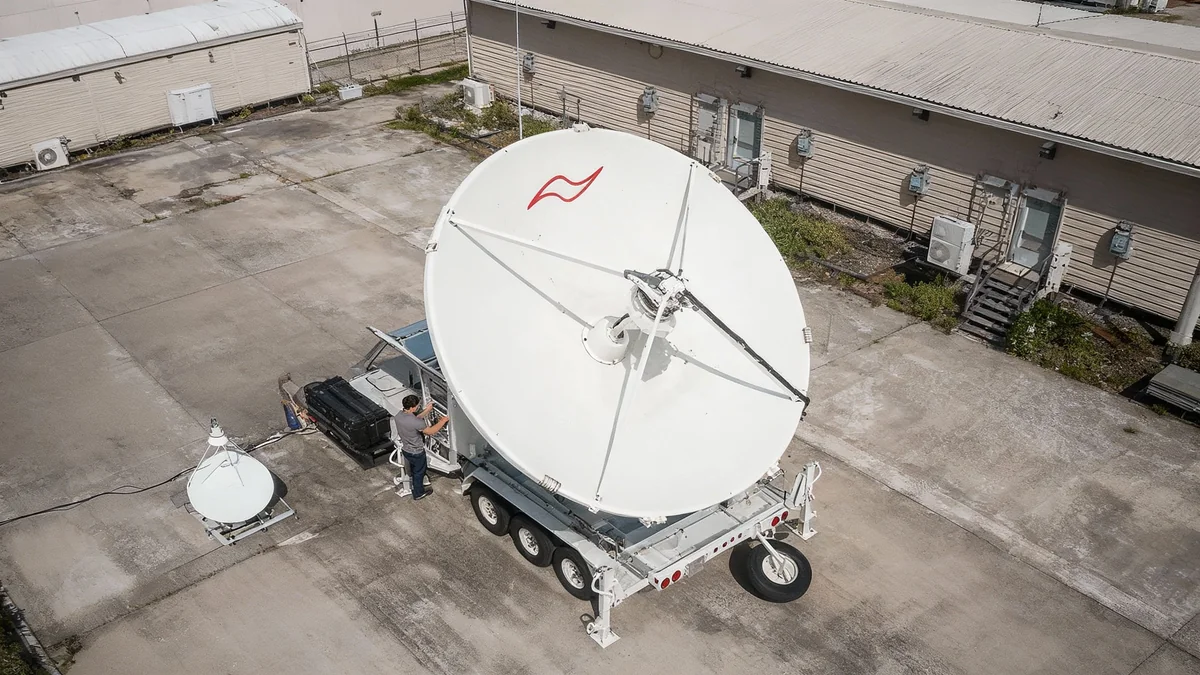The United States Space Force is on the verge of deploying two advanced ground-based weapons designed to temporarily disrupt the satellites of potential adversaries. According to newly released data, these systems are intended to counter the intelligence, surveillance, and reconnaissance capabilities of nations such as China and Russia.
The new electronic warfare platforms, named Meadowlands and the Remote Modular Terminal, represent a significant expansion of the nation's counter-space arsenal. They will join an existing capability, providing the Pentagon with a more flexible and robust set of tools to ensure space superiority in an increasingly contested domain.
Key Takeaways
- The US Space Force is set to field two new weapons for electronic warfare in space.
- The systems, Meadowlands and the Remote Modular Terminal, are designed to temporarily jam satellite signals.
- Their primary targets are intelligence, surveillance, and reconnaissance (ISR) satellites from China and Russia.
- This brings the Pentagon's total number of operational satellite jamming systems to three.
- The new platforms are more mobile and flexible than the existing Counter Communications System.
A New Era in Space Defense
The operational readiness of the Meadowlands and Remote Modular Terminal systems marks a critical step forward in U.S. military strategy. Unlike kinetic weapons that physically destroy satellites and create dangerous orbital debris, these systems employ reversible electronic effects. Their function is to jam communication links, temporarily disabling a satellite's ability to collect and transmit data without causing permanent damage.
This approach, often referred to as "reversible denial," is a cornerstone of modern space warfare doctrine. It allows military commanders to neutralize a threat during a conflict while minimizing the risk of long-term escalation or the creation of a hazardous space environment.
The development of these systems underscores a strategic shift within the Department of Defense. For years, U.S. military operations have been heavily reliant on a network of satellites for communication, navigation, and intelligence. Now, the focus has expanded to include actively defending those assets and denying similar advantages to adversaries.
Understanding Satellite Jamming
Satellite jamming is a form of electronic warfare where a powerful radio signal is directed at a satellite or its ground receiver. This signal overwhelms the satellite's own communications, preventing it from sending or receiving information. The effect is temporary and lasts only as long as the jamming signal is active, making it a non-destructive method of disabling an asset.
The New Systems: Meadowlands and RMT
The two new platforms provide distinct but complementary capabilities. Both are designed to be more mobile and adaptable than the military's first-generation satellite jammer.
Meadowlands: A Tactical Advantage
The Meadowlands system, developed by L3Harris Technologies, is a tactical-level jammer. Its design emphasizes mobility, allowing it to be deployed rapidly to different theaters of operation around the globe. This mobility is crucial for supporting ground troops who may be operating under the watch of enemy ISR satellites.
By temporarily blinding these satellites, Meadowlands can create windows of opportunity for friendly forces to maneuver without being detected. This capability directly enhances the safety and effectiveness of soldiers, sailors, and airmen on the battlefield.
The Meadowlands system is part of a broader U.S. military effort to develop transportable and expeditionary electronic warfare tools that can be integrated with other land, air, and sea assets.
Remote Modular Terminal (RMT)
Fewer details are publicly available about the Remote Modular Terminal, but it is understood to be a flexible system designed for remote operation. Its modular nature suggests that it can be configured for different missions and threats, providing a scalable solution for satellite denial.
The ability to operate the system remotely reduces the number of personnel required in forward-deployed locations, decreasing risk and logistical footprints. This aligns with the Space Force's goal of creating a leaner, more agile, and technology-driven service.
Building on an Existing Foundation
The introduction of Meadowlands and the RMT builds upon the foundation laid by the Counter Communications System (CCS), which was declared operational in 2020. The CCS is a larger, less mobile system composed of large dish antennas used to disrupt enemy satellite communications.
While effective, the fixed or semi-fixed nature of the CCS makes it a more predictable and potentially vulnerable target. The new systems address this limitation directly.
- Counter Communications System (CCS): A large, powerful, but less mobile system that has been in service and undergoing upgrades for years. It serves as the backbone of the military's satellite jamming capabilities.
- Meadowlands: A highly mobile, tactical system designed for rapid deployment to support regional combatant commands.
- Remote Modular Terminal (RMT): A flexible, remotely operated system that offers scalable effects and reduces personnel risk.
Together, these three systems create a layered defense. They provide the Pentagon with a spectrum of options, from broad, strategic-level jamming with the CCS to targeted, tactical denial with Meadowlands. This diversification makes the U.S. counter-space posture more resilient and adaptable to evolving threats.
"The ability to deny an adversary the use of their space assets without creating debris is a critical capability in any future conflict. These systems provide commanders with options that were previously unavailable."
The Geopolitical Context
The deployment of these new jammers is a direct response to the growing space capabilities of China and Russia. Both nations have invested heavily in developing their own constellations of military satellites and have demonstrated a range of counter-space weapons, from jammers to ground-based missiles capable of destroying satellites in orbit.
The Pentagon's strategy is not to initiate a conflict in space but to deter aggression by demonstrating a credible ability to respond. By fielding these non-destructive systems, the U.S. signals that it can neutralize threats to its space infrastructure without resorting to destructive force that could trigger a wider war.
According to U.S. intelligence assessments, both China and Russia view space as a critical warfighting domain and are actively developing capabilities to disrupt or destroy U.S. and allied satellites in a crisis.
The Space Force has been vocal about the need for what it calls "responsible military behaviors in space." The emphasis on reversible effects is a key part of this doctrine. By focusing on temporary and non-destructive measures, the U.S. aims to establish norms of behavior that discourage the use of weapons that create long-lasting orbital debris.
As the Space Force continues to mature, its focus will remain on maintaining a technological edge. The fielding of Meadowlands and the Remote Modular Terminal is a clear indication that the newest branch of the U.S. military is rapidly building the capacity to defend national interests in the ultimate high ground.





